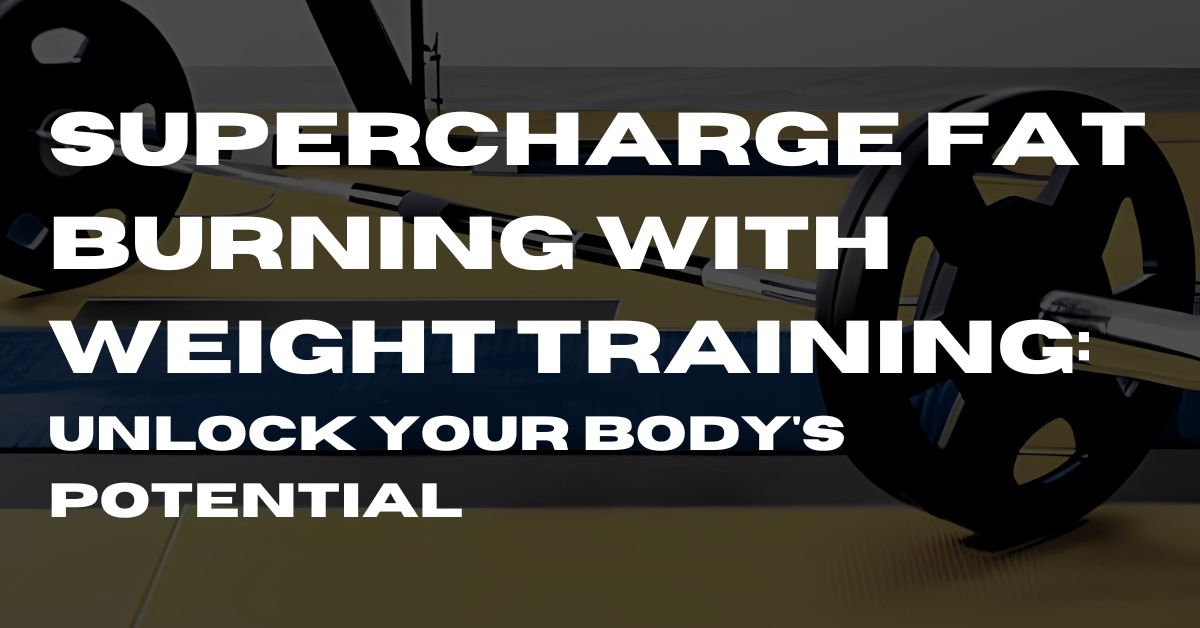Do weight training and burn fat go hand in hand? As a seasoned weight loss trainer, I am often posed with this intriguing question by individuals who are on a quest to shed those unwanted pounds. Today, I invite you on a journey of exploration into the world of weight training and its potential to ignite the fat-burning furnace within your body.
In this discussion, we will delve into the science behind weight training as a tool for fat loss, uncover the key mechanisms at play, and understand how incorporating this form of exercise into your routine can help you achieve your weight loss goals. So, buckle up and get ready to discover the incredible power of weight training in your fat-burning journey.
Understanding the Mechanism: How Weight Training Influences Fat Burning
When it comes to fat burning, weight training is a game-changer that deserves your attention. As an expert weight loss trainer, I have witnessed firsthand the transformative effects of incorporating weight training into a well-rounded fitness regimen.
Numerous studies support the notion that weight training not only helps build lean muscle mass but also plays a crucial role in burning fat. But how exactly does weight training influence fat burning? Let’s delve into the fascinating research and evidence that sheds light on this topic.
Research has consistently shown that weight training boosts your metabolism, both during and after your workout session. This phenomenon, known as excess post-exercise oxygen consumption (EPOC) or the “afterburn effect,” refers to the increased calorie burning that occurs even when you’re at rest after a weight training session. Studies have demonstrated that weight training can elevate your metabolic rate for up to 72 hours post-workout, resulting in a higher calorie expenditure and enhanced fat burning.
Additionally, weight training helps to increase your muscle mass. Muscles are metabolically active tissues, meaning they burn calories even when you’re not exercising. By engaging in weight training, you stimulate muscle growth and development, leading to an increase in your basal metabolic rate (BMR). A higher BMR implies that your body burns more calories throughout the day, including while you’re at rest, contributing to greater fat burning potential.
Furthermore, weight training promotes the utilization of stored fat as a fuel source during exercise. As you engage in resistance exercises, your body taps into its energy reserves, primarily targeting fat stores to meet the increased demands. Over time, this can lead to a reduction in overall body fat percentage, as your body becomes more efficient at utilizing fat as an energy source.
It’s worth noting that weight training is particularly effective in preserving muscle mass during weight loss journeys. When you create a calorie deficit through diet and cardio exercises alone, there is a risk of losing both fat and muscle mass. However, incorporating weight training helps mitigate this muscle loss by providing a stimulus for muscle maintenance and growth, ensuring that the weight you shed comes primarily from fat stores.
The Benefits of Weight Training for Fat Loss
1. Increased Metabolic Rate:
Weight training is a potent catalyst for elevating your metabolism, leading to increased calorie burning even when you’re at rest. Research consistently demonstrates that weight training has a profound impact on your metabolic rate, contributing to greater fat burning potential. For example, a study published in the Journal of Strength and Conditioning
Research found that individuals who engaged in weight training experienced a significant increase in resting metabolic rate that lasted for up to 72 hours post-workout. This prolonged elevation in metabolism not only translates to an extended period of heightened calorie expenditure but also creates a favorable environment for fat loss.
By incorporating weight training into your fitness routine, you can harness the power of an elevated metabolic rate and optimize your body’s ability to burn fat.
2. Muscle Preservation:
Preserving lean muscle mass is crucial when it comes to effective fat loss. Weight training serves as a vital tool in this regard by providing a stimulus for muscle maintenance and growth. Unlike crash diets or excessive cardio exercises, which may result in muscle loss along with fat loss, weight training helps preserve and even build muscle tissue.
This is essential because muscles are metabolically active, meaning they burn calories even at rest. When you engage in weight training, you stimulate muscle fibers, triggering a process known as muscle protein synthesis. This process not only aids in repairing and strengthening your muscles but also contributes to an increased metabolic rate.
By preserving and building muscle through weight training, you can create a favorable metabolic environment that supports fat loss and helps you achieve a leaner physique.
3. HIIT Integration:
High-Intensity Interval Training (HIIT) has gained recognition as a highly effective method for fat loss, and when combined with weight training, the results can be even more remarkable. By incorporating HIIT techniques such as circuit training or supersets into your weight training sessions, you can maximize your calorie burn and enhance cardiovascular fitness.
Research published in the Journal of Obesity revealed that combining weight training with HIIT resulted in greater reductions in body fat compared to traditional steady-state aerobic exercises. The intense bursts of effort during HIIT coupled with the muscle-building benefits of weight training create a powerful synergy for accelerating fat loss.
The combination of these two forms of exercise not only touches calories during the workout but also elevates your metabolic rate for hours after the session, leading to continued fat burning. By integrating HIIT into your weight training routine, you can supercharge your fat loss efforts and experience efficient and effective results.
4. Mindset and Motivation:
Weight training not only transforms your body but also has a profound impact on your mindset and motivation during your fat loss journey. As you embark on your weight training regimen, you’ll start noticing improvements in strength, endurance, and body composition.
These visible and tangible progressions serve as powerful motivators, boosting your confidence and dedication to reaching your fitness goals. The sense of accomplishment and empowerment gained through weight training can foster a positive mindset and the mental resilience needed to overcome obstacles and stay committed to your fat loss journey.
Moreover, weight training provides a structured and goal-oriented approach to your workouts, helping you stay focused and motivated. The continuous progress and improvement you experience in the gym can positively impact your mindset, transforming your perception of yourself and fueling your determination to achieve optimal fat loss results.
5. Aerobic Benefits:
While weight training is renowned for building strength and muscle, it also offers significant aerobic benefits. Incorporating compound movements, such as squats, deadlifts, or lunges, into your weight training routine engages multiple muscle groups simultaneously, leading to increased cardiovascular demands.
By reducing rest periods between sets and maintaining a higher intensity, your heart rate elevates, providing a cardiovascular workout alongside the fat-burning benefits of weight training. This efficient combination of strength training and cardiovascular exercise not only promotes fat loss but also improves overall cardiovascular health and endurance.
As your cardiovascular fitness improves through weight training, you’ll find that you can push yourself harder, recover faster, and sustain longer workouts, further enhancing your fat-burning potential.
6. Overcoming Plateaus:
Weight loss plateaus can be frustrating and demotivating, but weight training can help you break through these stagnant phases. When you consistently engage in the same exercise routine without challenging your body, it adapts to the stress, and progress may stall.
However, by incorporating weight training into your fat loss regimen, you introduce new challenges and stimuli to your muscles, preventing adaptation and promoting continual progress. Techniques such as progressive overload, where you gradually increase the weight or intensity of your exercises, can keep your muscles guessing and promote ongoing muscle growth and fat loss.
Additionally, changing your workout splits, such as implementing a Push-Pull-Legs (PPL) routine, allows you to target different muscle groups and optimize recovery, further aiding in overcoming plateaus. By incorporating these strategies into your weight training program, you can overcome stagnation, reignite your progress, and continue making strides towards your fat loss goals.
Designing an Effective Weight Training Program for Fat Loss
When designing an effective weight training program for fat loss, it’s essential to create a structured and progressive plan that combines resistance exercises, cardiovascular workouts, and proper nutrition. Here’s a step-by-step guide to help you create a program that promotes fat loss and supports your fitness goals:
1. Resistance Training:
Incorporating resistance exercises into your weight training program is crucial for fat loss as it helps build lean muscle mass and increases your metabolic rate. Focus on compound exercises that engage multiple muscle groups simultaneously, such as squats, deadlifts, lunges, bench presses, and rows.
These exercises require significant energy expenditure and stimulate muscle growth, which contributes to higher calorie burning both during and after your workout. Aim to perform 3-4 sets of 8-12 repetitions for each exercise, using weights that challenge you while still maintaining proper form. Gradually increasing the weight as you get stronger not only promotes muscle growth but also contributes to long-term fat loss.
Research supports the effectiveness of resistance training for fat loss. A study published in the Journal of Applied Physiology found that resistance training increased resting metabolic rate for up to 72 hours post-workout. Another study published in the International Journal of Obesity demonstrated that resistance training led to a significant reduction in fat mass and waist circumference in overweight and obese individuals. These findings highlight the metabolic benefits of resistance training and its potential for promoting fat loss.
2. High-Intensity Interval Training (HIIT):
HIIT workouts are a powerful addition to your weight training program for fat loss. HIIT involves alternating between short bursts of high-intensity exercises and brief periods of active recovery. This type of training not only burns calories during the workout but also elevates your metabolism, leading to increased fat burning even after the session ends.
Multiple studies have shown the effectiveness of HIIT for fat loss. Research published in the Journal of Obesity Reviews analyzed various studies and concluded that HIIT is more effective at reducing body fat compared to traditional steady-state aerobic exercise. Another study published in the American Journal of Physiology found that HIIT significantly improved insulin sensitivity and fat oxidation, contributing to greater fat loss.
3. Cardiovascular Exercise:

Including moderate-intensity cardiovascular exercises like jogging, cycling, or swimming in your weight training program further enhances your fat loss efforts. Cardiovascular exercise improves your overall fitness, burns additional calories, and supports heart health.
According to research, regular cardiovascular exercise has been associated with reductions in body fat. A study published in the Journal of Sports Science and Medicine found that a combination of resistance training and cardiovascular exercise resulted in greater fat loss compared to resistance training alone. Another study published in the British Journal of Sports Medicine demonstrated that regular cardio exercise was effective in reducing abdominal fat.
4. Mental Attitude and Determination:
Cultivating a positive mental attitude and strong determination is crucial for long-term success in any weight training program. Research has shown that individuals who have a positive attitude towards their fitness goals are more likely to adhere to their exercise routines and make sustainable lifestyle changes (*).
Setting realistic expectations and celebrating small victories along the way can boost motivation and help maintain a positive outlook. Additionally, focusing on the non-scale benefits of weight training, such as increased strength, improved body composition, and enhanced energy levels, can provide further motivation and reinforce the importance of the journey beyond just the number on the scale (*).
5. Meal Prepping and Macronutrients:

Planning and preparing meals in advance can help ensure that you’re fueling your body with the right nutrients for fat loss. Research suggests that individuals who engage in meal prepping are more likely to consume a well-balanced diet and make healthier food choices (*).
When it comes to macronutrients, a balanced approach is important. Consuming adequate protein is crucial for muscle growth and repair, and research has shown that higher protein diets can help preserve lean muscle mass during weight loss (*). Incorporating complex carbohydrates, such as whole grains, and healthy fats, such as avocados and nuts, provides sustained energy and essential nutrients to support overall health.
6. Consider a Vegan or Plant-Based Approach:

For those following a vegan or plant-based lifestyle, effective fat loss can still be achieved through weight training. Research has shown that well-planned vegan diets can be nutritionally adequate and may offer health benefits such as improved weight management (*).
Plant-based protein sources, including legumes, tofu, tempeh, and quinoa, can provide the necessary amino acids for muscle growth and repair (*). Combining these protein sources with a variety of vegetables, fruits, whole grains, and plant-based fats ensures a nutrient-dense and balanced approach to support fat loss goals.
7. Monitor and Adjust:
Regularly monitoring progress and making adjustments to the weight training program is important for continued success. Assessing body composition changes, strength gains, and overall well-being can help determine if any modifications are needed.
Consulting with a fitness professional or nutritionist can provide valuable guidance and ensure that the program aligns with individual needs and goals. Research suggests that individuals who receive guidance from professionals experience greater improvements in body composition and adherence to exercise programs (*).
Tips for Incorporating Weight-training in to workout routine
1. Start with Proper Form:
When incorporating weight training into your workout routine, it’s crucial to prioritize proper form and technique. This ensures maximum effectiveness and reduces the risk of injuries. Take the time to learn and practice the correct form for each exercise before adding weight.
Research published in the Journal of Strength and Conditioning Research highlights the importance of proper form for optimizing muscle activation and minimizing joint stress during weight training exercises. By maintaining proper form, you can target the intended muscle groups more effectively and reduce the likelihood of strains or sprains.
2. Begin with a Warm-up:
Before diving into weight training, it’s essential to warm up your muscles and prepare your body for the upcoming workout. Engage in dynamic stretches or light cardio exercises to increase blood flow, improve flexibility, and activate the muscles you’ll be targeting during your weight training session.
A study published in the Journal of Sports Sciences suggests that a proper warm-up can enhance muscle performance and reduce the risk of muscle injuries. Incorporating dynamic stretches and light cardiovascular exercises into your warm-up routine can help you perform better during weight training exercises.
3. Focus on Progressive Overload:
Progressive overload is a fundamental principle in weight training that involves gradually increasing the intensity, volume, or difficulty of your workouts over time. This progression stimulates muscle growth, strength gains, and fat loss.
Research published in the European Journal of Applied Physiology supports the effectiveness of progressive overload in promoting muscle hypertrophy and strength development. By consistently challenging your muscles with heavier weights, additional repetitions, or more challenging variations, you can continue making progress and achieve your fitness goals.
4. Include Compound Exercises:
Compound exercises should be the foundation of your weight training routine. These exercises engage multiple muscle groups simultaneously, allowing you to work more efficiently and burn more calories. Examples of compound exercises include squats, deadlifts, bench presses, overhead presses, and rows.
A study published in the Journal of Strength and Conditioning Research compared the energy expenditure of compound exercises versus isolation exercises. The researchers found that compound exercises elicited higher energy expenditure, making them more effective for calorie burning and fat loss.
5. Prioritize Rest and Recovery:
Adequate rest and recovery are essential components of an effective weight training routine. Allow your muscles time to repair and grow stronger by incorporating rest days into your schedule. Additionally, prioritize quality sleep, proper nutrition, and hydration to support optimal recovery.
Research published in the Journal of Applied Physiology suggests that proper rest and recovery between weight training sessions are crucial for muscle adaptation and growth. Neglecting rest can lead to overtraining, increased risk of injuries, and hindered progress.
Conclusion
Incorporating weight training into your workout routine can have a significant impact on your overall fitness and fat loss goals. By following these tips, including proper form, warm-up exercises, progressive overload, compound exercises, and prioritizing rest and recovery, you can create an effective weight training program that yields results.
Research and evidence support the benefits of weight training for muscle activation, strength gains, and fat loss. Studies emphasize the importance of proper form to optimize muscle activation and reduce the risk of injuries during weight training exercises. Additionally, warm-up exercises enhance muscle performance and reduce the likelihood of muscle injuries.
The principle of progressive overload, supported by scientific research, promotes muscle hypertrophy and strength development over time. By gradually increasing the intensity, volume, or difficulty of your workouts, you can continue making progress and achieve your fitness goals.
Compound exercises, such as squats, deadlifts, bench presses, overhead presses, and rows, are particularly effective for calorie burning and fat loss. These exercises engage multiple muscle groups simultaneously, allowing for efficient workouts and higher energy expenditure.
Prioritizing rest and recovery are crucial for muscle adaptation and growth. Adequate rest, quality sleep, proper nutrition, and hydration support optimal recovery and help prevent overtraining.

